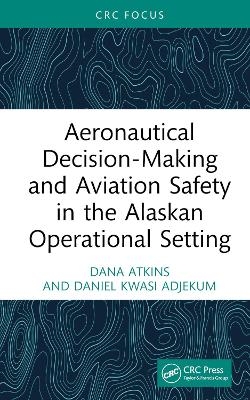
Aeronautical Decision-Making and Aviation Safety in the Alaskan Operational Setting
CRC Press (Verlag)
978-1-032-67474-2 (ISBN)
Aeronautical Decision-Making and Aviation Safety in the Alaskan Operational Setting introduces the reader to the real-life experiences of aviators who fly in remote settings such as Alaska in the United States. It covers the challenges related to limited aviation infrastructure and support that affect human factors like aeronautical decision-making and its impact on aviation safety.
Through a unique blend of meticulous case study analysis and semi-structured interviews with Alaskan pilots, this book offers a comprehensive understanding of the proverbial challenges of flying in Alaska. It uncovers the human factors elements specific to this environment, shedding light on the factors that influence a pilot’s decision-making, which may contribute to the high rate of accidents in Alaska and other remote regions. The content is supported by historical and socioeconomic perspectives on remote-setting aviation operations. Global perspectives are discussed with narratives from one author’s experiences flying to remote airstrips in Africa. The book concludes with practical recommendations to improve decision-making and aviation safety in these remote settings, making it a must-read for aviation professionals.
This insightful research is not just for academic consumption. It is a practical guide for aviation professionals, including pilots, dispatch teams, air traffic controllers, and aviation support personnel. It offers valuable insights into the human factors involved in flying in Alaska, which can be directly applied in other aviation resource-constrained geographical regions, making it an indispensable resource for those in the field.
Dana Atkins started her career flying medevac operations to remote locations across Alaska. She has flown for numerous operators in Alaska and previously flew the Boeing 767 domestically and abroad. She currently flies the Boeing 737 for a Legacy Airline in the United States. Dana holds a Master of Science (MS) in Aviation from the University of North Dakota. Her main research interests are the human factors of bush and backcountry flying in remote settings. Daniel Kwasi Adjekum is an assistant professor in the Department of Aviation, University of North Dakota, teaching courses in crew resource management, safety management systems, and human factors. He has over 24 years of experience as a former Ghana Air Force aircraft commander and aviation safety consultant. He has experience flying the BN-2T islanders and the Fokker F-27 into remote airstrips in Africa and previously flew the Boeing 737 aircraft for an international airline. Kwasi holds a Ph.D. in aerospace sciences. He is a globally recognized subject matter expert in aviation safety and a sought-after resource for global news media on aviation safety issues. He is also an International Air Transport Association (IATA) certified Safety Management Systems (SMS) implementation and control expert.
1 Aviation Operations in Remote Settings 1
What Are Remote Settings? 4
Transportation in Remote Settings 5
Remote Aviation Operations (Bush Flying) 7
Geography of the Bush 8
Aircraft 8
Airports/Aerodromes/Airfield Infrastructure 12
Regulatory Challenges 17
2 Fly Alaska: Remote Setting Operational Factors and Safety Implications 18
Fly Alaska: Historical Perspectives and Operations Safety 20
Historical Perspectives 20
Operations Safety 21
Organizational, Psychosocial, and Cultural Factors That Influence Operational Safety 22
Aviation Safety Management Initiatives—Effectiveness and Limitations 24
3 Theoretical Perspectives of Human Factors That Influence Aeronautical Decision-Making in Remote Operational Settings 28
Hazardous Attitudes and Pilot Personality 29
Anti-authority 30
Invulnerability 31
Macho 31
Impulsiveness 32
Resignation 32
Impact of Ego and Other Attitudinal Factors on Pilot Decision-Making in the Flight Deck 34
Goal Seduction, Plan Continuation Errors, and Pilot Decision- Making 35
Plan Continuation Errors 36
Foot-in-the-Door Persuasion 36
Social Theories Related to Operator Decision-Making 37
Social Identity Theory, Collective Self-efficacy, and Aviation Group Behaviors 38
4 Case Studies on Alaskan Aviation Operational Settings 40
Introduction to Alaska Case Studies 40
The Endemic of Controlled Flight into Terrain 41
CFIT Case Study: Togiak 41
Analysis 43
Organizational Culture and Accident Causation 48
Promech (Ketchikan) 48
Analysis 50
The Production and Protection Conundrum (External Pressures) 52
Ketchikan Mid-air 52
Analysis 53
5 Understanding Pilot Decision-Making in Alaskan Operational Settings: A Qualitative Approach 55
Interviewing 56
The Ethical Dilemma 57
Qualitative Data Analysis 57
Codes and Themes 58
6 Human and Organizational Factors Influencing Aeronautical Decision-Making in Remote Operational Settings: Real-Time Perspectives 60
Pilot Relationships 62
Pilot Attitudes 64
Skill Enhancement 68
Infrastructure Limitations 72
Organizational Factors 76
Regulatory Oversight 78
7 Push the Throttle, Let’s Fly Safely in Alaska’s Remote Settings: Concluding Perspectives and Reflections 81
Enhancing Aeronautical Decision-Making in Alaskan Aviation Operations Using Insider Perspectives 82
What Is Next for Aviation in Alaska? 85
Global Implications and International Perspective 86
Close Shaves in Northern Ghana 87
Concluding Remarks 91
Chapter References 93
Index 105
| Erscheinungsdatum | 18.09.2024 |
|---|---|
| Zusatzinfo | 6 Tables, black and white; 1 Line drawings, black and white; 10 Halftones, black and white; 11 Illustrations, black and white |
| Verlagsort | London |
| Sprache | englisch |
| Maße | 138 x 216 mm |
| Gewicht | 371 g |
| Themenwelt | Geisteswissenschaften ► Psychologie ► Allgemeine Psychologie |
| Geisteswissenschaften ► Psychologie ► Arbeits- und Organisationspsychologie | |
| Naturwissenschaften ► Biologie ► Ökologie / Naturschutz | |
| Technik ► Fahrzeugbau / Schiffbau | |
| Technik ► Luft- / Raumfahrttechnik | |
| ISBN-10 | 1-032-67474-1 / 1032674741 |
| ISBN-13 | 978-1-032-67474-2 / 9781032674742 |
| Zustand | Neuware |
| Haben Sie eine Frage zum Produkt? |
aus dem Bereich


